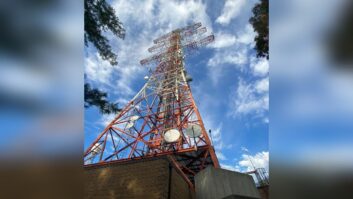As a long-time RW contributor (my first article was in June 1990) and even longer-time shortwave radio fan and broadcaster (Radio Canada International, HCJB in Ecuador, radioEARTH, and Monitor Radio; all sadly now defunct), I have been covering the revival of shortwave radio transmissions to Eastern Europe for RW with great interest.
So have our loyal RW readers, some of whom have taken great exception to our recent guest commentary, “Why Reviving Shortwave is a Non-Starter.” Written by Keith Perron (previously with Radio Netherlands, Radio Canada International, and BBC World Service) and Daniel Robinson (retired White House, congressional and foreign correspondent for Voice of America), their article argued against reviving shortwave radio to reach information-seeking listeners in Russia and Ukraine.
(Writer’s note: Both of these men have devoted much of their careers and passion to shortwave radio. Their credentials as shortwave enthusiasts are bona fide and undeniable.)
“Today, shortwave hobbyists assert that there is great value in beaming shortwave to Russia where a Putin crackdown closed independent media and pushed western reporters out,” said the Preeron/Robinson commentary. “But this is like claiming there is a VHS revival, because a few VCRs may still be floating around. At one time, there may have been millions of shortwave radios across the region. But no longer — gone are the days of people huddling around radios.”
Here’s what our readers had to say about it.
Shortwave Is Not Dead
RW reader and HAM (amateur radio) operator William Pietschman (W8LV) disagrees with the idea that shortwave radios have more or less vanished from Eastern Europe. “Shortwave is a ‘standard’ band found on MOST radios outside of North America, so shortwave radios didn’t disappear with the advent of the Internet,” he writes. “SETTING ASIDE Radio ‘hobbyists’, Shortwave radios are STILL being built by manufacturers such as Tecsun (and others) and they wouldn’t be producing them unless ‘someone’ other than ‘radio hobbyists’ was purchasing them.
“The idea of some saying Shortwave is dead is just as stupid as those same individuals saying constantly that Amateur Radio ( HAM) is dead or at least dying,” writes Gary L. Wesley, Jr. (W9CRT). “The fact is Russia and China have retained their Shortwave and analog capabilities to transmit news / propaganda as well as transmitting information / data to their military units on the ground and in the air.”
Sheldon Harvey is President of the Canadian International DX Club, a shortwave radio enthusiast organization established 50 years ago. (I know of Harvey and CIDX from my shortwave broadcasting days back in the 1980s; both were respected even then.)
Harvey writes, “Interesting as well that there is no mention in the commentary about the amount of money still being spent by the U.S. government on services like Radio Marti to Cuba; RFE/RL, Radio Free Asia, etc. which are all using shortwave. So is all of the money on these services simply being wasted because there are no shortwave radios out there and that no one is listening… Ask the Chinese Government what they think about the viability of shortwave broadcasting.”
“Why would several international shortwave broadcasters who lost their government funding choose to spend some of the little money they may have to purchase airtime on independent shortwave transmitters in places like the USA, Germany, France and other locations,” Harvey adds. “Why would they bother if no one was listening?
Shortwave Radios Are Widely Available
Some RW readers apparently viewed Perron/Robinson’s commentary as implying that shortwave broadcasting was no longer viable because shortwave receivers were no longer widely available. (They never made this claim, by the way.)
“Today, while the use of shortwave radio has dropped sharply over the last 20 years, it is paradoxical to note that it has never been so easy to listen to shortwaves in a very discreet way and for a very modest investment,” writes Paul Jamet from the French shortwave listeners’ group Radio Club du Perche. “Indeed, a few dozen euros are enough to acquire one of the many ultra-portable DSP receivers marketed by Chinese manufacturers, which most often use a Silicon Labs Si47xx (American) chip… Another paradox!”
Sheldon Harvey makes a similar point: “I’d ask anyone to do a search for ‘shortwave radios’ on any Internet marketplace site and you’ll see more companies and models than you could shake a stick at,” he writes. “There are more new models being released at a rate we have not seen for many years … There was a recent statement from Tecsun, from their Australian office, that quoted annual sales of a million-plus radios per year.”
Listener Groups Are the Tip of the Iceberg
One point in the Perron/Robinson commentary that put some readers’ nooses out of joint was the following: “Hobbyists and members of the amateur radio community are piling on governments in Canada, Australia and Sweden to revive shortwave. But purchasing new transmitters costs millions, and for an audience which is practically nonexistent.”
Harvey responded to this point by writing, “A search on Facebook for the word ‘shortwave’ for example will yield literally dozens of active groups of users of shortwave radios, literally spread throughout the world. Many of these groups have memberships of well over 1,000 members each, with some reaching 5-figure memberships.” He then notes that these relatively small numbers do not prove the absence of a much larger shortwave listener ‘Silent Majority’ (my Nixonian-era term, not his). “One could use the analogy that everyone who owns a camera does become a member of a photography club or group; same goes for shortwave listeners,” Harvey contends. “ Many of them don’t have dependable Internet service to even become members of these online groups.”
Russians Have Access to Radios
Another Perron/Robinson point that apparently irritated readers was this one: “Thousands, much less millions, of shortwave radios are not somehow hidden away in attics, though some commentators assert that people in Russia, particularly those with Cold War memories, will suddenly begin using shortwave to get around Putin and Xi Jinping’s firewalls.”
Paul Jamet tackled this one head-on. “Did the Russians and Ukrainians keep the receivers they used during the cold war? I don’t know,” he writes. “But what I do know is that many Russians buy DSP receivers via the AliExpress website! Their comments are numerous and easily spotted with the Russian flag … Also, why would several Chinese companies continue to invest in research and development to sell DSP receivers that perform amazingly well! I am not sure that the niche market for radio receivers is sufficient to make such investments worthwhile.”
Ruminations on Consequences
Within the comments received by RW were some ruminations on the consequences of governments having allowed shortwave to whither — a point raised by Perron and Robinson themselves – when the vulnerability of the web and local AM/FM retransmissions being blocked by hostile governments was obvious for all to see. (This reality has dogged me since the BBC’s decision to retreat from shortwave in favor of cheaper web and locally-retransmitted programming back in 2001. But nobody in power was apparently listening.)
As Gary L. Wesley, Jr. points out, digital media tends to fall short when things hit the fan. “People need to remember during 9/11 HAMs were there to support and pick up the OVERLOAD of the NY public service communications system,” he writes. “We were there for Katrina, the wildfires in the western United States and several other disasters. Feel free to promote the new forms of cellular communications however when it fails (and it has multiple times in the past), HAM radio will and Shortwave may be the only way people can get the life saving information they need.”
This being said, “It’s not cost effective to shut down and then rebuild shortwave infrastructure because of this reality,” William Pietschman writes. “As a matter of fact, it’s naive and foolish to not have adequate shortwave facilities activity broadcasting information worldwide. Now on the brink the like of which hasn’t been seen since the Cuban Missile Crisis, citizens abroad, armed with information might have acted as a deterrent to keep this war from starting in the first place.”
Closing Thoughts
As a shortwave enthusiast (and recently licensed HAM) who still has a longwire antenna and a radio room stocked with receivers — although not enough, because you can never have too many radios – I am more than sympathetic to the case made by RW’s readers in support of reviving shortwave broadcasts to Europe. And much as I respect the strong logic of Perron/Robinson’s closing argument that “In 2022, Ukrainians and Russians need 21st century solutions, not a legacy technology primarily being kept alive by hobbyists,” I am not sure that I agree with it.
After all, according to the Human Rights Foundation, USB drives are frequently used to smuggle forbidden information into North Korea. Now, a USB drive is not a shortwave radio, but the two can share the same purpose in closed societies: namely serving as the best available options for getting outside information in when most other paths have been blocked.
Meanwhile, although some Russians are reportedly using VPNs and the Dark Web to access Western news sites, I rather doubt that they are in the older age brackets. Meanwhile, internet access is not something that Ukrainian refugees can easily obtain, I suspect, while a portable radio is probably doable. This being said, Western broadcasts beamed onto these nations via AM/MW would be more likely to be heard than those carried on shortwave, because AM/FM radios are still ubiquitous.
The bottom line: The points raised by everyone in this debate are worth raising. Yet, all sides seem to share a common belief: The West needs to get uncensored news and information to Russians behind Putin’s ‘New Iron Curtain’. All that’s at issue is the best way to do it. Logically, using all means possible — including shortwave radio — would seem to maximize our chances of success.
[Related: “An Argument for Shortwave Radio, Its Benefits in Times of Crisis”]
James Careless is an award-winning freelance journalist with experience in radio/TV broadcasting as well as A/V equipment, system design and integration. He has written for Radio World, TV Tech, Systems Contractor News and AV Technology among others. Broadcast credits include CBC Radio, NPR and NBC News. He co-produces/co-hosts the “CDR Radio podcast” and is a two-time winner of the PBI Media Award for Excellence.




